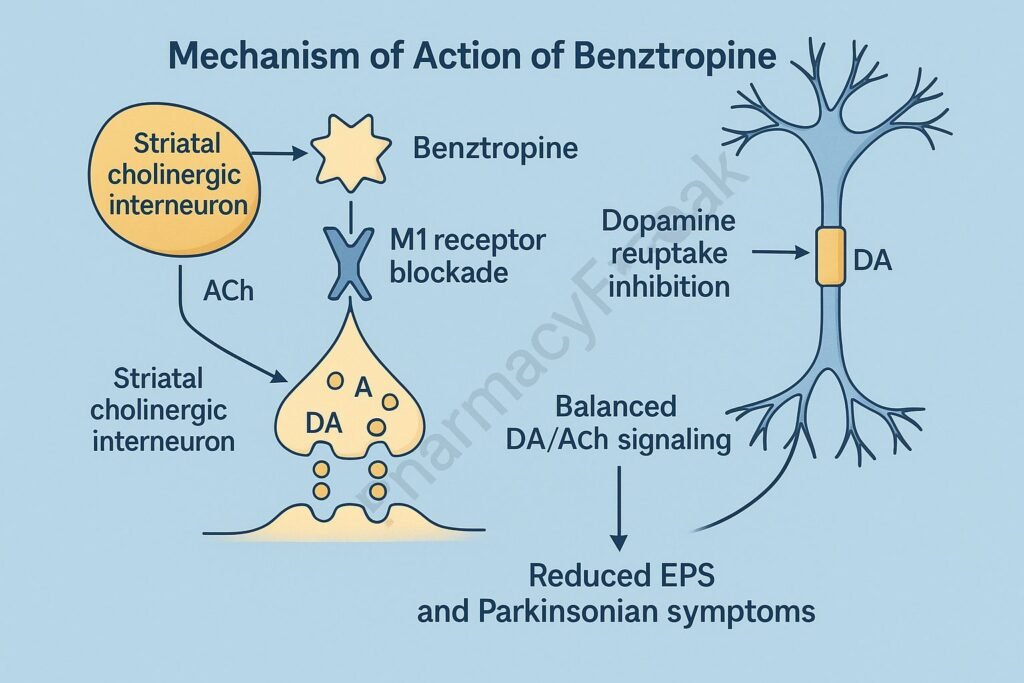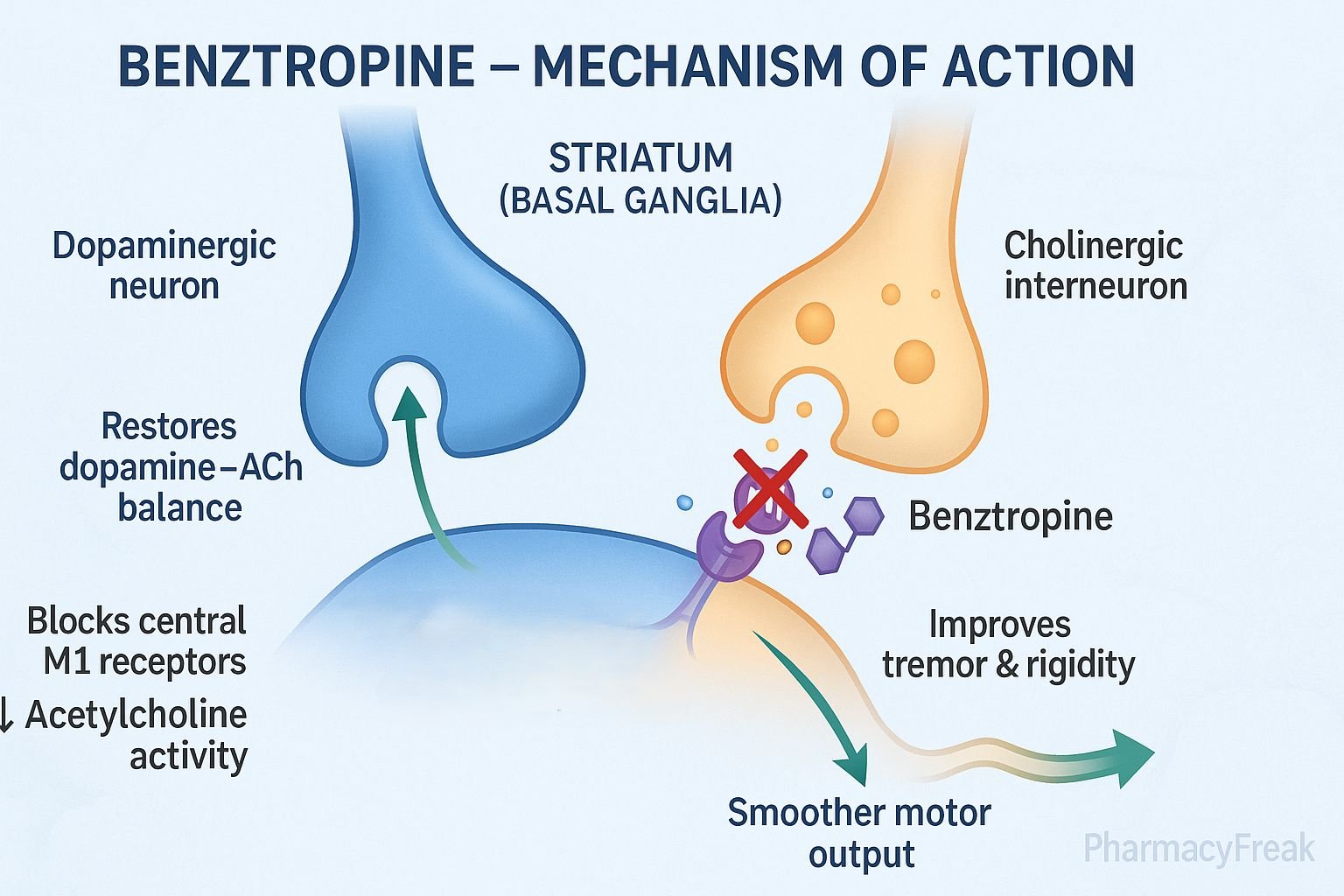Table of Contents
Introduction
Benztropine is an anticholinergic and antihistaminic medication commonly used in the treatment of Parkinson’s disease and drug-induced extrapyramidal symptoms (EPS) such as dystonia, akathisia, and parkinsonism caused by antipsychotics.
Its therapeutic effect comes from restoring the dopamine–acetylcholine balance in the basal ganglia. Benztropine blocks muscarinic receptors, reducing cholinergic activity, and provides antihistaminic sedation that additionally helps decrease movement abnormalities.


Mechanism of Action (Step-wise)
1. Muscarinic Receptor Antagonism (Primary Mechanism)
- Benztropine selectively blocks central muscarinic M1 receptors in the basal ganglia.
- In Parkinson’s disease and antipsychotic-induced EPS, there is low dopamine → relative excess acetylcholine.
- Benztropine reduces acetylcholine activity, restoring the dopamine-acetylcholine balance essential for smooth, coordinated movement.
Effect:
- ↓ Tremor
- ↓ Rigidity
- ↓ Akathisia and dystonia
- Improved motor control
2. Inhibition of Reuptake of Dopamine
- Benztropine weakly inhibits dopamine reuptake, increasing extracellular dopamine levels in the striatum.
- This mild dopaminergic effect contributes to improved movement and reduced rigidity.
3. Mild Antihistaminic (H1 Blocker) Action
- Benztropine has H1 antihistaminic properties.
- Provides mild sedation and contributes to motor stability in EPS.
4. Reduction of Cholinergic Transmission in Striatum
- Benztropine decreases cholinergic interneuron activity.
- This reduces excitatory output to motor pathways.
- Overall effect: reduced tremors and muscle stiffness.

Stepwise Summary of Mechanism
| Mechanism | Action | Effect |
|---|---|---|
| Muscarinic M1 blockade | ↓ ACh in basal ganglia | ↓ Tremor, ↓ rigidity |
| Dopamine reuptake inhibition | ↑ Dopamine | Better motor control |
| Antihistaminic effect | Mild CNS sedation | ↓ Restlessness |
| Cholinergic suppression | ↓ Motor excitability | ↓ EPS symptoms |
Pharmacokinetics
- Absorption: Well absorbed orally
- Distribution: Crosses the blood-brain barrier
- Metabolism: Hepatic
- Onset: 1–2 hours orally
- Duration: 6–12 hours
Clinical Uses
- Parkinson’s disease (tremor predominant)
- Drug-induced extrapyramidal symptoms (EPS) including:
- Acute dystonia
- Akathisia
- Drug-induced parkinsonism
- Adjunct in movement disorders caused by antipsychotics
- Post-encephalitic parkinsonism
Adverse Effects
- Dry mouth
- Blurred vision
- Constipation
- Urinary retention
- Tachycardia
- Cognitive impairment
- Confusion or hallucinations (elderly at higher risk)
Contraindications
- Glaucoma (especially angle-closure)
- Urinary retention
- GI obstruction
- Severe cognitive impairment
Comparative Analysis
| Feature | Benztropine | Trihexyphenidyl | Levodopa |
|---|---|---|---|
| MOA | M1 antagonist | M1 antagonist | Dopamine precursor |
| Best for | Tremor, EPS | Tremor, EPS | Bradykinesia, rigidity |
| Cognitive effects | Moderate | Moderate–high | Low |
| Use in drug-induced EPS | Excellent | Excellent | Not used |
MCQs
1. Benztropine improves EPS primarily by:
a) Increasing serotonin levels
b) Blocking muscarinic receptors
c) Increasing GABA release
d) Enhancing NMDA activity
Answer: b) Blocking muscarinic receptors
2. The dopamine–acetylcholine imbalance in Parkinson’s is corrected by:
a) Increasing dopamine reuptake
b) Decreasing acetylcholine activity
c) Blocking dopamine receptors
d) Increasing glutamate release
Answer: b) Decreasing acetylcholine activity
3. Benztropine is MOST useful for treating:
a) Tardive dyskinesia
b) Tremor-dominant Parkinsonism
c) Depression
d) Schizophrenia
Answer: b) Tremor-dominant Parkinsonism
4. A major side effect of benztropine is:
a) Diarrhea
b) Urinary retention
c) Excessive salivation
d) Bradycardia
Answer: b) Urinary retention
5. Benztropine’s dopaminergic benefit comes from:
a) Increased dopamine synthesis
b) Dopamine reuptake inhibition
c) D2 receptor activation
d) Inhibition of dopamine metabolism
Answer: b) Dopamine reuptake inhibition
FAQs
Q1. Can benztropine treat tardive dyskinesia?
No, it worsens tardive dyskinesia and should never be used for it.
Q2. Why is benztropine used for EPS caused by antipsychotics?
Antipsychotics decrease dopamine → excess acetylcholine. Benztropine reduces this excess ACh.
Q3. Is benztropine sedating?
Mildly, due to its antihistaminic (H1) action.
Q4. Why should benztropine be avoided in elderly patients?
It increases the risk of confusion, hallucinations, and memory impairment.
Q5. Can benztropine be stopped suddenly?
Abrupt withdrawal may worsen parkinsonism or EPS; tapering is preferred.
References
Goodman & Gilman’s Pharmacological Basis of Therapeutics
Katzung Basic & Clinical Pharmacology
Tripathi Essentials of Medical Pharmacology
Harrison’s Principles of Internal Medicine

I am pursuing MBA in pharmaceutical management from NIPER Hyderabad with a strong academic record and proven success in national-level pharmacy entrance exams. I secured AIR 61 in NIPER 2024 (MS/M.Pharm) and AIR 27 in NIPER MBA, along with AIR 147 in GPAT 2024 and AIR 907 in GPAT 2023. I also achieved AIR 6 in AIIMS CRE-2025 for Drug Store Keeper and was selected as a Pharmacist (AIR 61) for ESIC. Additionally, I was the Runner-Up in Round 2 of the EY Case Study Competition.
At PharmacyFreak.com, I aim to guide future pharmacists through expert content, exam strategies, and insightful resources based on real experience and academic excellence.
Mail- harsh@pharmacyfreak.com
